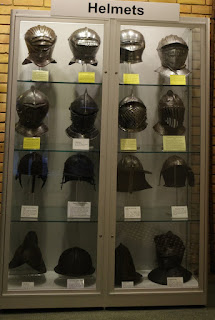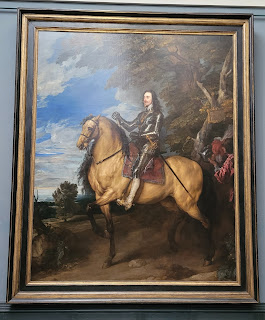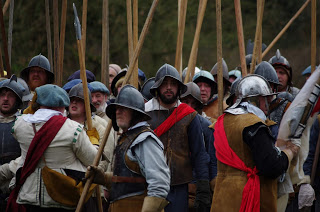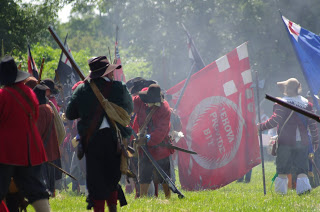Rupert's March North: Part Two, Lancashire
Part two of the Prince Rupert travelogue sees him venture through Lancashire towards York, and ultimately the battle of Marston Moor.
For ease of writing south of the Mersey is 'Cheshire', north of the Mersey is 'Lancashire'.
After crossing the Mersey, Rupert bypassed Manchester as it was too well defended, instead storming Bolton.
Two of the Royalist regiments of foot had returned from fighting in Ireland, and during the initial attack a number of their men were captured. An Irishman was hung by the defenders as they saw the presence of Irish men (and whole regiments of Catholic Irishmen, so they believed) as a Papist attack on their Calvinism. Bolton was a hotbed of Calvinism and known, at the time, as the 'Geneva of the North'.
Once in the town, Rupert's men, insensed by the hanging, showed no quarter. Up to 1600 defenders and residents were slaughtered in the streets. Recent appraisal of parish records show in the region of 150 casualties, but many would have been unrecorded. Regardless of the true number of casualties, the Massacre fuelled the Parliamentarian propaganda machine.
The Earl of Derby was captured in 1650, and taken to Bolton for execution in 1651. The execution took place outside Ye Olde Man and Scythe pub. A market cross nearby has plaques commemorating the event.
Latham House was under siege for most of 1644, the Countess of Derby refusing to surrender to Sir Thomas Fairfax. The House was heavily fortified, and Black Tom could not gain the upper hand. The siege was lifted when Rupert's advance drew near.
The House was besieged again in 1645, only this time the Countess wasn't at home to oversee the defending forces. After five months the defenders surrendered as it was clear no-one was coming to their aid.
Little remains of Lathom House now, the house was demolished almost immediately after the siege. There are extensive earthworks associated with the siege visible using LiDAR, but you will struggle to find them on the ground. The only visible recognition of the events is the Cromwell Stone, now found in the grounds of Lathom Park Chapel. Local stories say that the round indentations were used as moulds for cannonballs.
After the Bolton Massacre, Rupert rested in Bury for five days before turning for Liverpool. A five day siege saw Rupert take the city and the castle. Rupert and his army torched whatever they could find, leaving Liverpool in ruins.
Thanks to the handiwork of Rupert's army, the Georgians, the Victorians, the Luftwaffe, and Liverpool City Council planning department in the 1970s, there is nothing from the civil war period to see. The only reference to it is the locally named 'Prince Rupert's Tower' an 18th century lock-up in Everton (and which is immortalised on Everton F.C.'s badge).
Meanwhile, Charles's council of war had stripped Oxford of it's defenders in an attempt to swing the war in the south west. Oxford was now threatened by the armies of the William Waller and the Earl of Essex, so Charles left for Worcester, writing to Rupert of his predicament. This letter was slightly ambiguous, and Rupert's interpretation led to him relieving York then heading straight out to battle on Marston Moor.
Rupert's numbers had now swelled to about 14000, his march to Yorkshire took him, relatively uneventfully through Clitheroe, and Preston whose garrison surrendered without a shot being fired, before crossing the Pennines.
Other stuff:
Manchester has the dubious distinction of being the location of the first recorded casualty of the First English Civil War. A street fight on 15th July 1642, claimed the life of Levenshulme linen weaver Richard Perceval, when Royalists tried to force the town to hand over its gunpowder stores. Perceval, was allegedly killed by Thomas Tyldesley of Astley. Proceedings were begun against Thomas Tyldesley for the killing; however, on 11th August the House of Commons ordered the judges in Lancashire to cease the action.
Wythenshawe Hall: yet another beautiful timber framed house in South Manchester. Well it was until some little bugger set fire to it in 2016. Needless to say the Hall is shut due to restoration work. April 2022 update: renovations are now completed, final touches are being put to the Hall, and it is due to reopen to the public soon.
Wythenshawe Hall was besieged late 1643, eventually falling to Parliament when they wheeled some big guns over from Manchester.
A statue of Oliver Cromwell was relocated from outside Manchester Cathedral to the parkland of Wythenshawe Hall in the 1980s.
Selected Bibliography
The Civil War In Lancashire S.Bull, Lancashire County Books
The History of the Siege of Manchester J.Palmer, Partizan Press
Postcodes for SatNavs
For ease of writing south of the Mersey is 'Cheshire', north of the Mersey is 'Lancashire'.
After crossing the Mersey, Rupert bypassed Manchester as it was too well defended, instead storming Bolton.
 |
Immediately after Storming Stockport his army camped on Barlow Moor in what is now Didsbury. A plaque on Didsbury Library marks the spot.
 |
| Didsbury being Didsbury: for political balance, the neighbouring plaque to Rupert's, marks Brereton's mustering of Parliamentarian troops. |
Rupert attacked Bolton on the 28th of May three days after taking Stockport. The loss of Stockport led to the Parliamentarian forces besieging Lathom House to retreat to Bolton. The attack started in pouring rain, the 4000 defenders repulsing the Royalist attacks. A fresh attack led by the Earl of Derby broke the defensive line.
James Stanley, Earl of Derby
Two of the Royalist regiments of foot had returned from fighting in Ireland, and during the initial attack a number of their men were captured. An Irishman was hung by the defenders as they saw the presence of Irish men (and whole regiments of Catholic Irishmen, so they believed) as a Papist attack on their Calvinism. Bolton was a hotbed of Calvinism and known, at the time, as the 'Geneva of the North'.
Once in the town, Rupert's men, insensed by the hanging, showed no quarter. Up to 1600 defenders and residents were slaughtered in the streets. Recent appraisal of parish records show in the region of 150 casualties, but many would have been unrecorded. Regardless of the true number of casualties, the Massacre fuelled the Parliamentarian propaganda machine.
The Earl of Derby was captured in 1650, and taken to Bolton for execution in 1651. The execution took place outside Ye Olde Man and Scythe pub. A market cross nearby has plaques commemorating the event.
Ye Olde Man and Scythe
Ye Olde Man and Scythe is well worth a visit, and not just for it's famous selection of fruit ciders on draught. On display (second room on the right as you go through the front door) in a glass cabinet is the chair that Derby sat on whilst waiting for his final appointment. Easily spotted due to the theatrical axe and bloodied head resting upon it. There are also a number of Civil War pictures on the walls (reenactors, newspaper articles, representations of the Storm of Bolton etc).
Latham House was under siege for most of 1644, the Countess of Derby refusing to surrender to Sir Thomas Fairfax. The House was heavily fortified, and Black Tom could not gain the upper hand. The siege was lifted when Rupert's advance drew near.
The House was besieged again in 1645, only this time the Countess wasn't at home to oversee the defending forces. After five months the defenders surrendered as it was clear no-one was coming to their aid.
Little remains of Lathom House now, the house was demolished almost immediately after the siege. There are extensive earthworks associated with the siege visible using LiDAR, but you will struggle to find them on the ground. The only visible recognition of the events is the Cromwell Stone, now found in the grounds of Lathom Park Chapel. Local stories say that the round indentations were used as moulds for cannonballs.
The Cromwell Stone
After the Bolton Massacre, Rupert rested in Bury for five days before turning for Liverpool. A five day siege saw Rupert take the city and the castle. Rupert and his army torched whatever they could find, leaving Liverpool in ruins.
Thanks to the handiwork of Rupert's army, the Georgians, the Victorians, the Luftwaffe, and Liverpool City Council planning department in the 1970s, there is nothing from the civil war period to see. The only reference to it is the locally named 'Prince Rupert's Tower' an 18th century lock-up in Everton (and which is immortalised on Everton F.C.'s badge).
Prince Rupert's Tower, Everton
Whilst in Liverpool, visit the Walker Art Gallery to view one of the most famous Civil War paintings (even though it is Victorian) Yeames's 'And When Did You Last See Your Father?'
Meanwhile, Charles's council of war had stripped Oxford of it's defenders in an attempt to swing the war in the south west. Oxford was now threatened by the armies of the William Waller and the Earl of Essex, so Charles left for Worcester, writing to Rupert of his predicament. This letter was slightly ambiguous, and Rupert's interpretation led to him relieving York then heading straight out to battle on Marston Moor.
Rupert's numbers had now swelled to about 14000, his march to Yorkshire took him, relatively uneventfully through Clitheroe, and Preston whose garrison surrendered without a shot being fired, before crossing the Pennines.
Other stuff:
Manchester has the dubious distinction of being the location of the first recorded casualty of the First English Civil War. A street fight on 15th July 1642, claimed the life of Levenshulme linen weaver Richard Perceval, when Royalists tried to force the town to hand over its gunpowder stores. Perceval, was allegedly killed by Thomas Tyldesley of Astley. Proceedings were begun against Thomas Tyldesley for the killing; however, on 11th August the House of Commons ordered the judges in Lancashire to cease the action.
Manchester had declared for Parliament at the outbreak of war, and had hired a German mercenary, Colonel Rosworm, to defend the city. Considerable defences were erected, but this did not deter Lord Strange (soon to become the Earl of Derby) attacking the city on 26th September 1642. Firing cannon down Deansgate, but to no avail. Lifting the siege in October, as the city was deemed impregnable.
A blue plaque on the side of Richer Sounds on Deansgate marks the location of Alport Lodge, from where Strange fired his cannons. There's an information panel opposite Richer Sounds, on the reverse there is some information about the Royalist artillery park. (There used to be a fancier board with more information, and cannons!)
A blue plaque on the side of Richer Sounds on Deansgate marks the location of Alport Lodge, from where Strange fired his cannons. There's an information panel opposite Richer Sounds, on the reverse there is some information about the Royalist artillery park. (There used to be a fancier board with more information, and cannons!)
Very little of 'old' Manchester remains, the Victorians, the Luftwaffe, the IRA, and Manchester City Council's planning department have seen to that; however a few 'original' buildings have survived.
The medieval buildings that would become Chetham's Library were utilised as a prison for Royalists, an armoury, and a powder store. The library is open for guided tours, sadly no discount for descendants of the founder.
There are a small number of buildings still standing that will have witnessed the events of the siege.
The Old Wellington, and Sinclair's Oyster Bar both date from the 1500s and have had interesting 'lives' during the twentieth century: raised on stilts during the development of the Arndale Centre, then taken apart, reconfigured and relocated following the IRA bombing, and subsequent redevelopment of the Arndale. Worth a visit for post Library tour refreshments, but how much of the original 1500s buildings remain is debatable.
Manchester Cathedral has, at its core, buildings from the fifteenth century, but Victorian expansion of what was a collegiate church into a cathedral, and an almost direct hit from the Luftwaffe has scarred the original building and destroyed much of the internal fabric of the building. The inside still has discolouration from the fire started by the bomb.
Wythenshawe Hall: yet another beautiful timber framed house in South Manchester. Well it was until some little bugger set fire to it in 2016. Needless to say the Hall is shut due to restoration work. April 2022 update: renovations are now completed, final touches are being put to the Hall, and it is due to reopen to the public soon.
Wythenshawe Hall was besieged late 1643, eventually falling to Parliament when they wheeled some big guns over from Manchester.
 |
| Wythenshawe Hall pre-arson attack |
 |
| No cheating! All four Cromwell statues feature in ECWtravelogue posts - can you find them? No prizes I'm afraid, just a smug feeling of superiority |
Selected Bibliography
The Civil War In Lancashire S.Bull, Lancashire County Books
The History of the Siege of Manchester J.Palmer, Partizan Press
Postcodes for SatNavs
Didsbury Library M20 2DN
Ye Olde Man and Scythe BL1 1HL
Cromwell's Stone L40 5UQ
Prince Rupert's Tower L5 4LS
Richer Sounds, Deansgate M3 4JB
Ye Olde Man and Scythe BL1 1HL
Cromwell's Stone L40 5UQ
Prince Rupert's Tower L5 4LS
Richer Sounds, Deansgate M3 4JB
Chetham's Library, Long Millgate M3 1SB
Wellington/Sinclair's, Cathedral Gates M3 1SW
Manchester Cathedral, Victoria Street M3 1SX
Wythenshawe Hall M23 0AB
Footnote: having followed Rupert's route to the Pennines, it would be only right and proper to continue and follow his route to York. I blame Michael Portillo for this self imposed weight of expectation.
Part 1 points of interest - purple
Wythenshawe Hall M23 0AB
Footnote: having followed Rupert's route to the Pennines, it would be only right and proper to continue and follow his route to York. I blame Michael Portillo for this self imposed weight of expectation.
Part 1 points of interest - purple
If you enjoyed reading this, or any of the other posts, please consider supporting the blog.
Thanks.


















Comments
Post a Comment